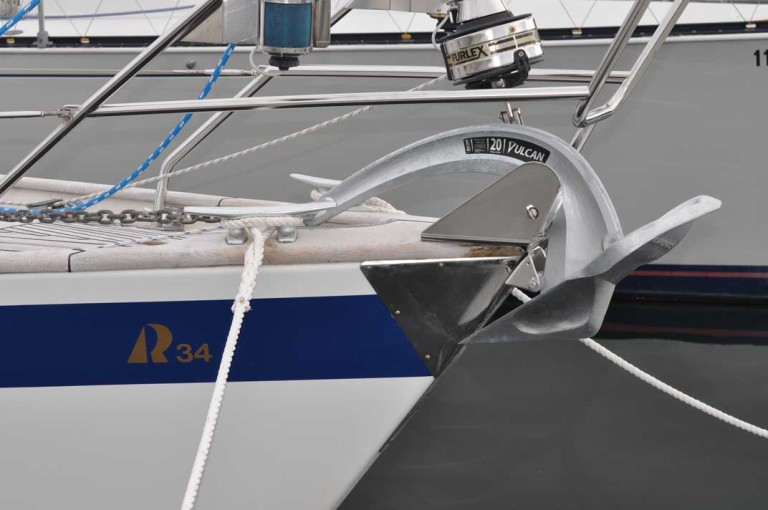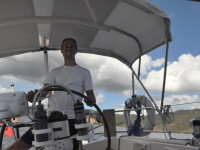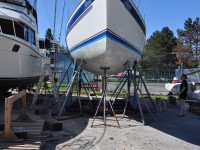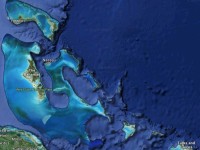Other than the bilge drain plug, I can’t think of a single piece of gear that has seen more hours of use doing what it was intended to do than our anchor. Sure puts it’s importance in perspective doesn’t it. So now that I have enough experience to be a crusty old salt, its time to share my experience with the CQR, Vulcan (Rocna), Bruce and Fortress anchors. For those that have followed us for the past two years, you may recall from my post last summer that we upgraded, from a 45lb CQR to a Vulcan 20 model (by Rocna) weighing in at 44 lbs. So we have a year of experience with each anchor as our primary anchor. In addition we have a 15 lb Bruce that serves as an auxillary and an aluminum Fortress that was sized to be an emergency primary anchor in case we had to abandon our primary until it could be retrieved.
Of course, no anchor discussion is complete without the crusty old salts that are too stubborn to pry open their wallets to replace their CQR and will look down their noses at me over their glasses to inform me that as long as it is set properly, the CQR will hold just fine.
And I agree, BUT it can frequently be an exercise in frustration to get the CQR to set properly. Most of the time it is buried sideways instead of right side up, and it will hold for an average night, but what about when the Christmas winds arrive in the Carribean coupled with a squally night? There is a reason why in anchor tests it will hold against 800 lbs of pull on one attempt and then 5000 in the next; the CQR just isn’t reliable or consistent in the way it sets. Meanwhile the newer generation anchors are much more consistent, both in testing and in my personal experience.
To Summarize how they work:
Vulcan: Lands upright or rolls upright immediately, sets, damn near every time and usually within a few feet of where it lands.
CQR: often evidence that it has dragged 10 to 30’ before digging in. Then you have to haul it up an try again because you ended up too close to shore or another boat.
Vulcan: Digs in and sets in designed orientation.
CQR: lays on its side most of the time.
Vulcan: if a gust accelerates the boat backward above 0.5kn, while paying out the chain, it still sets.
CQR: Above 0.3kn it skates across the surface indefinitely.
Vulcan: Once it starts to dig in, you can rev the engine (in reverse) in one smooth motion from idle to 2500 rpm to bury it.
CQR: If you do the above, half the time it breaks free and the boat takes off in reverse. You need to gradually rev up over 3 to 5 minutes to coax it to dig in.
Vulcan: Will dig into a grassy sea bed.
CQR: Seldom penetrates a grassy sea bed.
Vulcan: Huge shovel does take waves when pounding upwind in fresh wind and seas, but it fits in the chain locker on passage.
CQR: Easier to secure on the bow roller, but does not fit anywhere in the boat for storage on passage.
Vulcan: Still has good holding power at short scope
CQR: No comment.
Vulcan: Self launches from the bow roller.
CQR: Requires a big push off the bow roller to deploy.
Vulcan: Marriage saving.
CQR: The opposite.
Vulcan: Is actually paying for itself in reduced diesel, engine hours and windlass wear and tear because it usually sets.
CQR: Will add a touch of ‘old salt’ style to a garden someday

We had the option to anchor way out from shore in Martinique and have a bumpy night, or up close in grass. I think the price of the anchor was nearly justified for these 2 nights alone.
We are tremendously happy with our new anchor. On our worst night of the season in Deshaies our anchor held against the odds, when we were forced by the boat that anchored too close behind us to go to ultra short scope for the conditions (until he dragged away).

This is an adequate set with the Vulcan in thin sand over a hard bottom. In regular sand you often wont even see the anchor.
As for the scorecard, both our CQR and our Vulcan dragged once on us. The instance with the CQR occured about 10 minutes after we had set it. We were in a bumpy anchorage for the sole purpose of taking Magnus to the vet, and we had backed down at near full engine RPM just to be sure we had it set. Chrissy and the dog were in the dinghy and as I about to climb in, I realized the anchor had let go. If it had happened 5 minutes later Altera would have been on shore when we came back.
The Vulcan pulled out in the Bahamas after we had spun several circles in light winds and ended up upside down. The sand was so soft that the shank sank into the sand preventing the Vulcan from flipping upright and resetting. I suspect this would be a rare case, as that is the only time I’ve seen the bottom that fluffy and light.
On another occasion, the wind shifted about 50 or 60 degrees and it pulled out. Imagine my surprise when I snorkeled over it! But we backed down on it with the engine and it dug right in. And, nothing is perfect in thin mud, but it seems the Vulcan needs extra scope and needs longer to settle than I would have expected. But it did hold us in a less than ideal spot when we arrived late for the busy Annapolis Sailboat Show.
Technique and other anchoring thoughts.
Like most things with cruising, anchoring is a steady learning curve. What sometimes seemed straight forward in the ultra protected anchorages of Georgian Bay, can make even an experienced sailor a rookie in places in the Caribbean or Bahamas. So here are some of the things I’ve learned along the way to get the anchor to set, regardless of which one it is.
Point the boat into the wind, coast to a stop where you want to lower the anchor. In calm conditions when you start dropping the chain, you can feather the boat in and out of reverse to lay out the chain as straight as possible until it is ready to set. This was typical on Georgian Bay for us. Go dead slow. Even though our new anchor has a higher tolerance for digging in, it still works more reliably when the boat is going dead slow. Watch a youtube video of an anchor manufacturers test. They just gently tug the chain to coax it to set, not pull it at a mile or more an hour. GPS is a powerful tool, watch the speed, keep it below 0.3 kn.
When you are in a wide open anchorage characteristic of the Caribbean and the wind is gusting (sometimes to 30 knots or more), it gets a little trickier. Believe me, the first few weeks in the islands took some getting used to. Monohull sailboats have a lot of windage between the mast and headsail. For Altera, all of this is forward of the fin keel, so once the wind blows even slightly across the bow, Altera’s bow gets pushed off course. In these cases, I motor in at about 1 kn or a bit more to maintain steerage. When we reach the spot we want the anchor, Chrissy starts lowering it and I stop us using reverse. I watch objects around be to judge when Altera is just about stopped and put it in neutral. Don’t use the GPS for this, it has a lag, and by the time it says you are stopped you will be accelerating in reverse and with gusty winds you will rapidly be going too fast for the anchor to catch.
At this point the wind inevitably catches the bow and Altera will spin, drifting sideways as the chain is laid out. This is OK, don’t try to force a monohull sailboat to stay aligned to the wind. Trying to fight against wind and current will only get you in trouble. Classic rookie mistake. I’ve bought that t-shirt and learned my lesson. You landed the anchor where you wanted, that’s what matters. Once the chain has paid out, the boat will align with the wind. Then you know it is time to back down on it. You don’t look incompetent if your fin keel sailboat is drifting sideways while the chain is being let out. You will however look incompetent if you try and fight it and will be significantly increasing your odds of trying again.
Sometimes anchorages are busy, or the most protected spots where you will get the most sleep are. To find a space, take your time. Meander through and try to weave your way into the middle of neighbouring boats. This way you will pass through places where you look around and realize if I put the boat here, after letting out my chain, I will fit and have enough room to swing. Once you find that spot, gauge where 2 or 3 boat lengths ahead of you is relative to the boats around you and steer your bow to drop the anchor.
In tight spaces and gusty conditions, as you make the final approach you will have to go fast enough to maintain steerage. Use your depth sounder to your advantage and let out enough chain so that the anchor is just above the bottom. When you reach that spot, it will only take a couple seconds for the anchor to land where you want it then its business as usual. If you wait to start dropping the chain until you are stopped you will be blown away on a windy day before the anchor touches the bottom and will be hauling up the anchor for an encore performance.
And, Please, back down on your anchor! Rev it up and hold it there for a minute or two. Be sure it is set. Once you’re done snorkel or dinghy over it if the water is clear. I’ve had our chain catch under a rock giving the impression the anchor was set, only to find that the anchor is sitting on the top with 15’ of slack chain between the anchor and the rock. Fine until the wind shifts.
It still boggles my mind seeing cruisers come in let their chain out while coasting slowly in reverse and then seconds later the engine is off… All done. Some of them I’ve seen pay the price in the middle of the night. Don’t be one of them.
And finally when you go out to buy your new anchor, Go Big. We contemplated going with the smaller 15 kg model when we made the change because it has the same holding power as a heavier CQR, but ultimately are glad we went the way we did. Sleeping soundly at night is important. Plus, some of the best places or common stops between places to visit can be busy and bigger anchors are more tolerant of shorter scope. On our miserable night in Deshaies for the 30’ water depth we were in we should have been on at least 4:1 scope when the boat that had anchored too close behind us forced us to pull chain in to a little over 3:1 with the winds approaching 25 knots sustained. After he dragged away, I put out more scope to about 5:1 which matches the recommendation for the 30 knot sustained winds we saw soon after for that water depth.
Instead of one Big anchor can’t you just use two anchors when it is really windy? Technically yes, but in practice, No. When you deploy 2 anchors from the bow, the boat is going to be fetching up and moving around in the conditions where you would do this. As a result it is only really pulling on one anchor at a time, so the load is not shared. This will just drag one anchor, then the next and so on until they rodes are all twisted and the anchors might foul each other. The last thing you want you want is to be dealing with twisted rodes in the middle of the night while you are dragging down on the boat behind you. In my opinion, 2 anchors only work if each of them can hold the boat in those conditions. Then the second anchor is simply there for redundancy or to limit your swing in close spaces.
The other Anchors:
Admittedly I have only attempted to use our Fortress anchor once as it requires some assembly to use and we just didn’t have a need. It is light weight being aluminum and disassembled is easy to store, but is limited in usefulness as it is really only designed for deep sand or mud bottoms. I tried to use it in thin sand on a hard substrate and I could pull it along like a rake while I was snorkelling trying to get it to set. The intended purpose was to limit our swing room as we were in close quarters with light shifting winds. Ultimately it was not successful. By contrast the Vulcan in the same bottom had plowed a mound of sand and nosed into a deeper patch of sand when it had the chance. We anchored in this same spot about 6 times in a month and each time, the Vulcan performed the same so it wasn’t a one off fluke. If I were to do it again, I’d just get a smaller Vulcan as my backup anchor as it has proven to be far more versatile. The other option would be the Spade which is very similar in design, but the shank can be removed for more storage possibilities.

Fortress: Generally reported to be good in sand, but as I learned, only if the sand is deep.
Surprisingly, our little 15lb Bruce (generally regarded as very undersized for our boat, and really only useful for an auxillary anchor) was able to bite into the bottom that the fortress didn’t. And it held us stern to the swell for several days so that we didn’t wake up rolling side to side in the middle of the night. It has dug in very securely on a few other occasions as well. Generally, a very user friendly anchor, but ultimate holding power is usually reported to be low for these anchors, so if you use it as a primary you need to go really big. They are also prone to setting sideways with just 1 of their 3 flukes buried, which is probably where the low holding power claims arise. Having a small anchor like this on board makes it easy to deploy from the dinghy which was great on the few occasions where we wanted it.
Ultimately, if you are going cruising get yourself a generously sized Rocna, Vulcan or Spade. I’d be surprised if you regret it.




I now feel fully informed with regards the benefits of a good anchor. I now have to persuade your Grandfather to give sailing a whirl, after all with a Grandfather who was a Midshipman on a three master clipper I would have thought that it would be in his blood, that didn’t work either. I will keep trying. Nan
Hello,
I found your text on anchors very informative.
I have unrelated questions (regarding sails) but I do not how to contact you, if not by leaving a comment.
On the Alera page, you mention having a working jib and a 50% heavy weather jib.
I have myself an HR34 and would be interested in investing in such kind of sails – possibly with the installation of an inner forestay.
I have a couple questions
– how do you use these sails? Apparently you use the standard rails an rollers. Does that work well with those jibs. Can you trim in and sail with a good angle
– do you have the specifications of your sails ? Surface ? etc.
– do you set them on a inner forestay ?
Well all information regarding these heavy weather sail would be useful.
Thanks a lot and congratulations for your nice website
Hello Antoine,
Great to hear from another HR 34 owner. I’ll send you a message with my contact information and then we can discuss your questions on sails etc.
We have an old HR 35 Rasmus and are thinking about an inner forestay. We run our current storm jib the same way as the other foresails, hanked on. Any information about how the inner forestay is mounted would be interesting to me.
Sorry, we don’t actually have an inner forestay. Just a small 50% jib that fits on our furler.
Hello.
We have a HR 34 2003 mod. Read your comments on anchors with great interest since we are in the same process as you have been about leaving the CQR for a Vulcan (15 or 20) or Spade.
You seems to be happy with your choice and from what i understand you did not have to do any modifications on the bowroller ? On our boat we have a HR bowladder and a remoweable bowsprit for the gennaker. Do you have any experience with regards to the bowladder and bowsprit ? Does it work with the Vulcan on the bow ?
Hello Trond, we were very happy with the Vulcan 20kg. As an anchor it worked very well for us. The downside is it doesn’t sit as well in the bow roller as the shank is narrow and all the weight is in the spade. I put a rubber bumper on the bow and we snug it up tight against it with the windlass it stays in place but it has rattled around upwind in bigger seas. I’ll send you a picture, it wasn’t hard to do. Offshore, I wedge in the anchor roller between fenders which has worked well so I don’t have worry about it if the windlass doesn’t hold or the lashing chafes.
Jeff,
Pardon me for using this forum to reach out to you, believe I saw your boat listed for sale. I have been looking for a Hallberg Rassy in these waters ( I Live in Oakville). I can be reached at rkrish123@yahoo.com.
Cheers!
Rajesh.K
Yes, it may have been our boat that you saw for sale, however Altera has been sold.
Thanks for responding Jeff.. TC